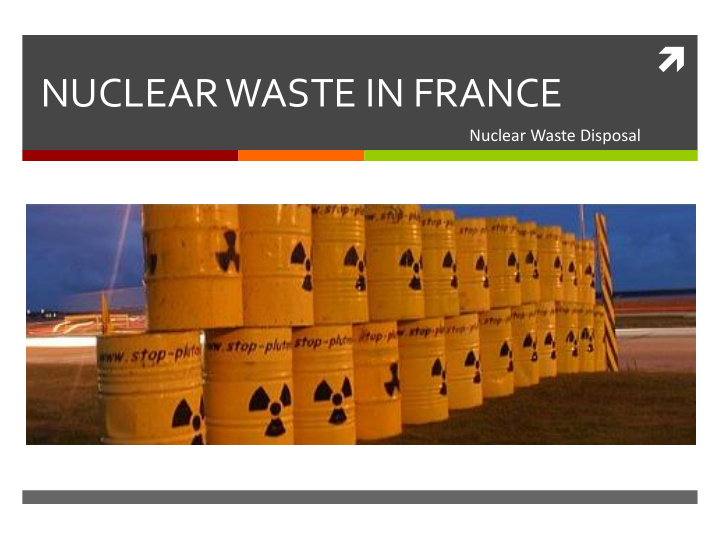



NUCLEAR WASTE IN FRANCE Nuclear Waste Disposal
Storage of nuclear waste in France Two problems : 1200 tons of nuclear - Traitement the used nuclear fuel waste produced each year in France - Storing the waste which can’t be reused
Very low activity waste: 8% of the waste Stored in large basins (100m x 20m x 8m) in the Andra : These basins are insulated from the soil by a 2 cm thick polyetylene membrane and covered by a thick layer of clay at the top: Andra
Low & middle activity waste: 85% This type of waste are solidified and coated of concrete or bitumen Then, stored in steel or concrete containers in two places in France: - La Hague since 1969 and FULL since 1994 :
- L’ Adran (National agency of the treatment of the nuclear waste) in the Aube departement, since 1992: it can accomodate 1 millions m3 of waste = 50 years of waste production : 8 m 25 m These buildings are covered by clay earth and The water under the blocks is collected to be treated
High activity waste: 0,2 % of the waste Vitrified in a solid and stable shape Stored in large pools or in ventilated shafts in two site in France: La Hague and Marcoule 100 m 3 produced each year La Hague Marcoule
What about the future ? France hasn’t still decided a long term solution for the storage of the high activity waste From 1991 until 2006, researches about 3 possible solutions: - Transmutation - Deep geological waste storage - Surface storage Finally, deep geological storage was decided in 2006 & The Cigéo project plans the openning of deep geological storage in 2025
Deep geological storage in France Main requirements : - Insulate the waste from the biosphere until they will be harmless - Create a reversible storage (in the first time) with the possibility to take back the waste if it’s needed - Find a geological stable location for the storage - Avoid the water infiltration
The future locations One of the future deep repository should be in the little town of Bure in the north east of France
The city already accomodates a laboratory of researches The future site will be around the laboratory at the depth of 500m in the 130m thick layer of clay
Two barriers: 1/ Geological barrier: the clay In Tournemire, in the south of France, the site is quite similar as the one in bure. The samples taken at 500m of depth show that the clay (which as the same characteristics as in Bure) is completely waterproof: the water can move ten meters in 1 millions of years. The clay is tight and stable
2/ Engineered barrier : Container surrounding the waste with benonite which is able to swell to make the barrier tight Every containers should be separated by a space to avoid a temperature higher than 100 ° C which could alterate the bentonite Finally, after 150 years of supervision when the site will be completely stable, the project plans to bury all the storage …
Which limits ? This kind of deep repository hasn’t been yet realized, in many countries (USA, Czech Republic , France…) all the projects are still under the study. BUT In Germany, in the Asse, a former salt mine was used as a deep geological repository
In 1964, after the closure of the mine, the government bought the mine to order some researches about the storage of the nuclear waste. Between 1967 and 1978, 125 000 containers of low activity waste and 1300 containers of medium activity waste were stored there without any precaution. Normally, the salt should be the best hermetic barrier for the storage of the waste BUT because of the high number of tunnel constructions and the decades of use, the deformation in Asse II has reached the state that the pressurised salt is losing its stability Water infiltration Corrosion of the metal containers by salt began in 1985 water LEAK OF NUCLEAR WASTE
Eventually, many cavities of mines are contaminated, according to recent samples, the rate of cesium is 8 times higher than the standard. The contaminated water was pumped and rejected few hundred meters deeper which leaded to a big scandal in Germany. Finally, this huge disaster reveals the importance of serious researches about the stability of the site for a deep repository. In this way, France and European researches keep going in order to get the openning of a deep repository in France in 2025. But this project will still have to face the public opposition…
Recommend
More recommend